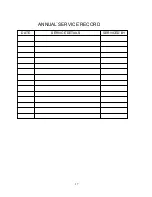
lighting again. If you need to press the reset again, wait at least ten seconds before doing this. If there is a
lot of air in the pipeline, it may be necessary to repeat this reset procedure several times.
• When the pilot lights, the ECS system shuts down the ignition spark and then turns on the gas supply to the
main burner. This will ignite shortly after.
• Once the main burner is alight, the size of the flame can be adjusted using the top rocker switch on the
handpiece. Pr increases the flame. Note that the response to flame adjustment may take about
twenty seconds, so the rocker switch should be held down until the flame reaches the desired height.
• While the heater is being switched on and off by the wall thermostat (if fitted), the red indicator light beside
the receiver will remain alight, showing that the heater is ready to light again when the room temperature
falls. The flame will light at its last height setting. The pilot light extinguishes each time the flame
extinguishes.
• If the mains supply to the heater is switched off, the fire will light next time at the LOW flame setting, but if
the mains supply is uninterrupted, the flame will light again at its last setting.
• The lower rocker switch on the handpiece controls the fan, switching it to ‘OFF’, ‘LOW’, ‘MEDIUM’ and
‘HIGH’ sequentially. NOTE. The fan is also controlled by an internal switch which will not permit it to
start until the fire is hot (about ten minutes from cold on high fire) and will keep it running after the fire
goes out. The handpiece will not start the fan during the warm-up period, but it can pre-select the speed at
which the fan will start once the firebox is hot.
NOTE: Occasionally the electrical system may ‘lock up’. Turning off the mains supply for ten seconds will
clear this.
TURNING THE FIRE OFF:-
ALL MODELS EXCEPT ECS:-
• Push down and turn the control to the ‘PILOT’ position. Alternatively, models fitted with wall mounted or
portable thermostats may be shut down at the thermostat. The pilot will remain alight.
• If the fan is running, turn it off either at the rotary switch or the wall socket. (STD models only). Models
fitted with internal switches will stop after the firebox has cooled.
• To extinguish the pilot light on STD models, press down on the control and turn it fully clockwise to the
‘OFF’ position. To extinguish the pilot light on ACC and RMT models, press the PILOT control knob part
way down and turn it fully clockwise.
ECS MODELS:-
• To stop the fire immediately, press the TOP button on the handpiece once or press the small button by the
receiver (on the pedestal foot) once. The indicator light by the receiver will extinguish, the fire and pilot
light will shut down and the fan will stop. Alternatively, turning off the mains plug switch or moving the
slide switch on the wall thermostat away from ‘HEAT’ will extinguish the fire.
• To stop the fire after a delay of about 30 minutes, press the BOTTOM button on the handpiece. The
indicator light beside the receiver will start flashing and eventually the fire will shut down. Pressing the
delayed stop button again during the shutting down period will restore the heater to normal continuous
operation.
RECEIVER SWITCH POSITIONS (ACC and RMT models)
The receiver switch has three positions, ‘OFF’, ‘ON’ and ‘REMOTE’.
‘OFF’ prevents the main burner from being lit. This is a useful safety feature if children might play with the
remote control.
‘ON’ bypasses the remote control entirely, allowing the heater to be lit even though the batteries in the receiver
or remote control are dead, or, in the case of the RMT model, if the mains power supply has failed. In this
setting the thermostat is inactive and the heat output is fixed on LOW for RMT models. It may be controlled
manually on all other models.
‘REMOTE’ brings the remote control into full operation, allowing its in-built thermostat to match heat output
to the heating needs of the area the remote control is in, provided that the remote control is left pointing toward
the heater. For automatic heat control with RMT models, the remote control must be ‘ON’ in the ‘AUTO’
mode. The remote control can be set to automatically run the heater within any desired time period. See the
separate remote control operating instructions for full details.
5






































